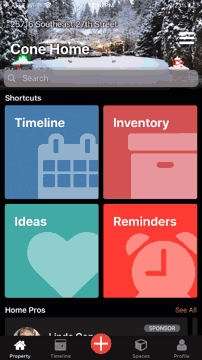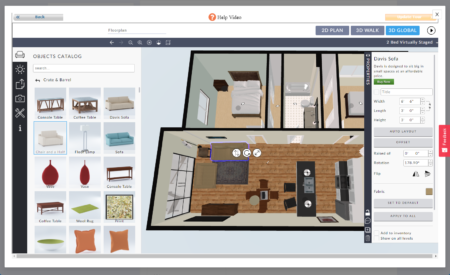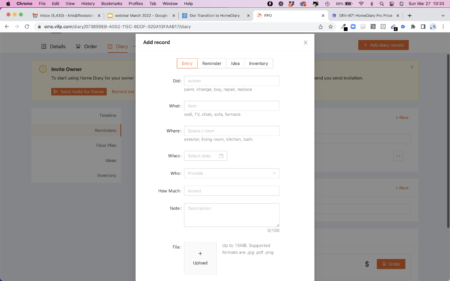HomeDiary is a fully realized home asset tracking solution for homeowners and their agents. Spaces, its clever, easy-to-use room management interface, allows users to set up a layout of custom-labeled room cards
Are you receiving Inman’s Agent Edge? Make sure you’re subscribed for the latest on real estate technology from Inman’s expert Craig Rowe.
HomeDiary is a fully realized home asset tracking solution for homeowners and their agents.
Platforms: Browser app; iOS companion app
Ideal for: New homeowners, agents
Top selling points:
- Spaces, room-by-room management
- On-board floor-planning and inventory oversight
- Interior space modeling
- Timeline of home maintenance
Top concern:
The array of products and capabilities here can be a tad overwhelming in terms of how it all interconnects. I had a hard time understanding what aspect of the solution was of the most value. Hopefully, this is merely a sales communication issue that can be sorted out upon inquiry.
What you should know
HomeDiary competes on multiple levels in the space. It offers digital floor plans, home tour captures, virtual staging, Matterport integration, interactive room design and a range of related interior modeling tools. On that front, the software delivers on its promises quite confidently. It’s been offering such features for quite some time and is only now pushing into the home inventory management as a long-term agent-to-owner touchpoint strategy.
Given the software’s affordability, agents should have little hesitancy about setting up an account for gifting their buyers after closing.
There’s a lot to unpack with this software, and I felt that the folks showing it to me didn’t quite know how to best present all it can do. Because it can do a lot. However, there are a couple of cool, smart modules that stand out.
The Spaces feature caught my attention and I hope the team at HomeDiary finds a way to make this the primary launchpad of the user experience. It’s kind of what I was hoping to see from the start, as I’ve seen all kinds of ways to photograph receipts and track home upkeep expenses. The two-way companion app offers an easy method for doing this, however. That’s handy.
Spaces allows users to set up a layout of custom-labeled room cards. Each includes a nice summary of the space, an easily identifiable picture and the ability to click into more details. They can jump into the digital floorplan to further reference room details in case a renovation or new furniture is on the way. There’s also a timeline of each thing done to the room, from painting to a window repair. Inventory is tracked, too.

It’s this kind of simplicity in user experience that helps such a data-rich tool be more manageable, especially in light of what I referenced earlier in terms of how to best find value in an app that offers a number of related, but not always desired accessories.
The Timeline view helps me like HomeDiary, too. I wish the folks who owned my home before me bothered to log their work. I’ve spent a few thousand dollars in unseen fixes as part of a multi-room renovation project because of head-shaking decisions made by previous owners over the years. Had someone taken some photos and added a few details, I could have had my contractors address those concerns in their initial estimates.
My home was built in the 1970s, but the sellers did work on it in the last 10 years. Throw me a bone, folks. I’ve seen cellophane offer better wind resistance than my windows.
Point is, I better understand the value of tracking such things, and thus my overall sentiment toward software in this category has warmed a little.

Still, to what extent will gifting this app to your client earn you repeat business? Hard to say, as is the case with most of these products. But the software does offer some ways to actively remain a part of your client’s homeownership journey.
Agents can add Reminders to the user’s Home Diary, and each will be noted as such. They can also add notes to the ledger. If a reminder has to do with a specific service or maintenance item, the agent can include a link to the preferred vendor within the system.
There’s a home tour included upon sign-up, which is free, by the way. And agents can invite as many clients as they want to create Home Diaries; there’s no limit. However, there are fees associated with packaging the product as a closing gift, as that is what ignites the long-term interaction.

Yes, there’s more to this product, such as property videos that can be automatically unbranded for MLS use, 2D slide shows and website creation and marketing features, all part of the team’s first and concurrent industry product, Floorplanonline. It should be noted that their 3D, digital twin offering is proprietary, meaning it’ll stand out from the more common players in this category.
As of our demo, HomeDiary itself, a rebrand of sorts from the aforementioned company, is in beta. Summer 2022 is the expected formal launch date. I’m sure they’d welcome interest in being part of the beta group.
I think it would be worth a go.
Have a technology product you would like to discuss? Email Craig Rowe
Craig C. Rowe started in commercial real estate at the dawn of the dot-com boom, helping an array of commercial real estate companies fortify their online presence and analyze internal software decisions. He now helps agents with technology decisions and marketing through reviewing software and tech for Inman.



 Are You Interested in West Eleventh Residences Miami?
Are You Interested in West Eleventh Residences Miami? Are You Interested in ONE Park Tower by Turnberry?
Are You Interested in ONE Park Tower by Turnberry? Are You Interested in Diesel Wynwood Condominium?
Are You Interested in Diesel Wynwood Condominium? Are You Interested in Five Park Miami Beach?
Are You Interested in Five Park Miami Beach? Are You Interested in Cipriani Residences Miami?
Are You Interested in Cipriani Residences Miami? Are You Interested in Bentley Residences Miami?
Are You Interested in Bentley Residences Miami? Are You Interested in Baccarat Residences Brickell?
Are You Interested in Baccarat Residences Brickell? Are You Interested in Aria Reserve Miami?
Are You Interested in Aria Reserve Miami? Are You Interested in 888 Brickell Dolce & Gabbana | Miami?
Are You Interested in 888 Brickell Dolce & Gabbana | Miami? Are You Interested in 600 Miami WorldCenter?
Are You Interested in 600 Miami WorldCenter? Are You Interested in HUB MIAMI RESIDENCES?
Are You Interested in HUB MIAMI RESIDENCES? Are You Interested in WALDORF ASTORIA RESIDENCES?
Are You Interested in WALDORF ASTORIA RESIDENCES?